
 |
Eager Space | Videos | All Video Text | Support | Community | About |
|---|

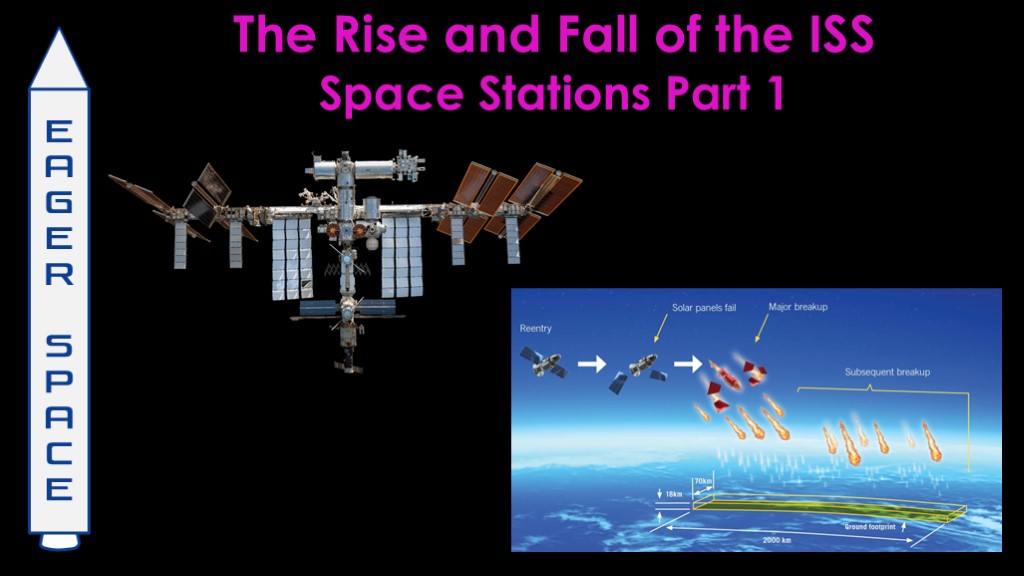
NASA integrated Program Plan 1970 : https://www.wired.com/2012/04/integrated-program-plan-maximum-rate-traffic-model-1970/
ISS Deorbit analysis summary white paper: https://www.nasa.gov/wp-content/uploads/2024/06/iss-deorbit-analysis-summary.pdf
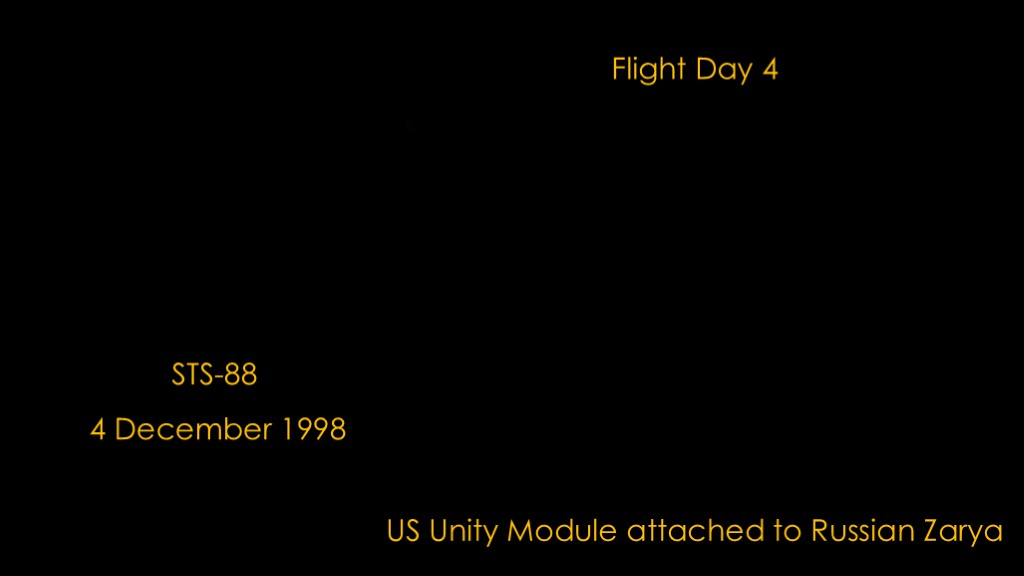
And with that, the first two modules of the international space station - the unity module from the US and the Zarya module from Russia - were attached, and the space station was born
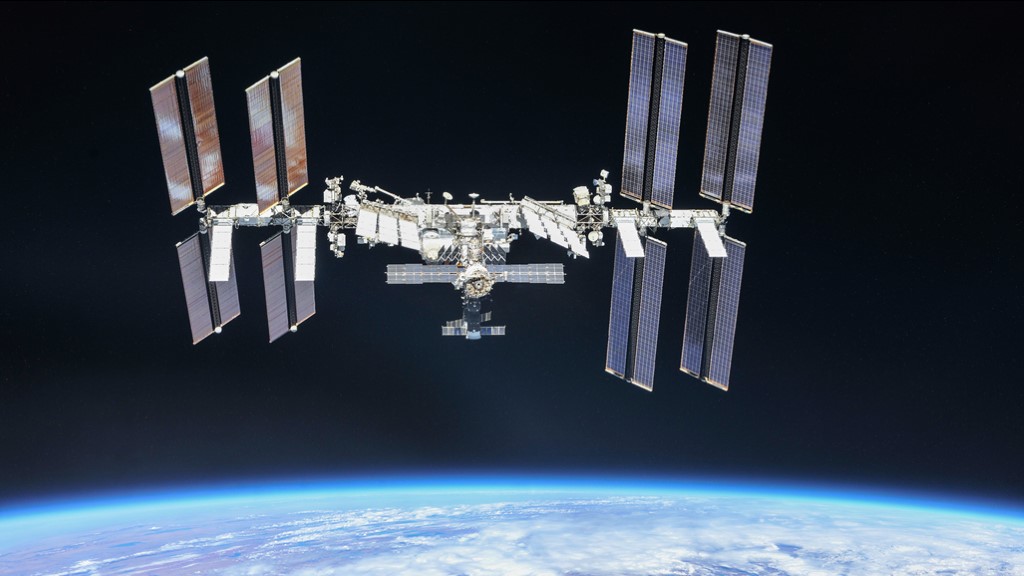
The international space station has been a fixture at NASA since that first assembly flight in 1998, but with some of the elements in their mid-20s, at some point it will no longer be safe for Astronauts and Cosmonauts to occupy.
This is the story of the space station - why it was built and what will happen when it's no longer safe.
This is the rise and fall of the ISS.
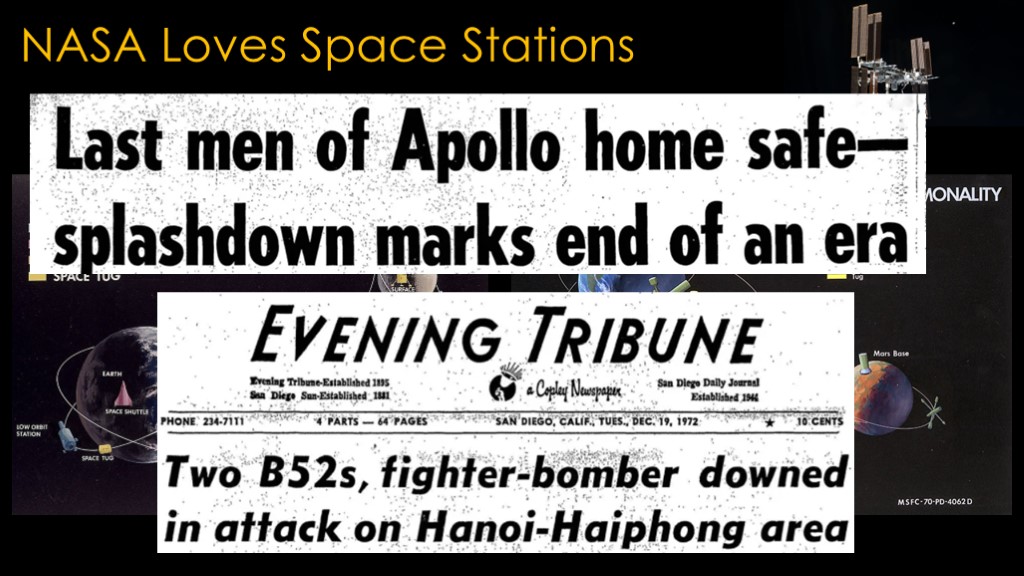
Back the late 1960s, NASA had really big plans.
Plans for bases on the moon and mars, space stations around both of them, space tugs, and shuttles, both conventional and nuclear.
But Congress cancelled the moon program, and Apollo 17 was the last flight. The US had won the race to the moon and that was the source of most of the backing for the program, and it's clear that the government had other issues to focus on, including the war in Vietnam.
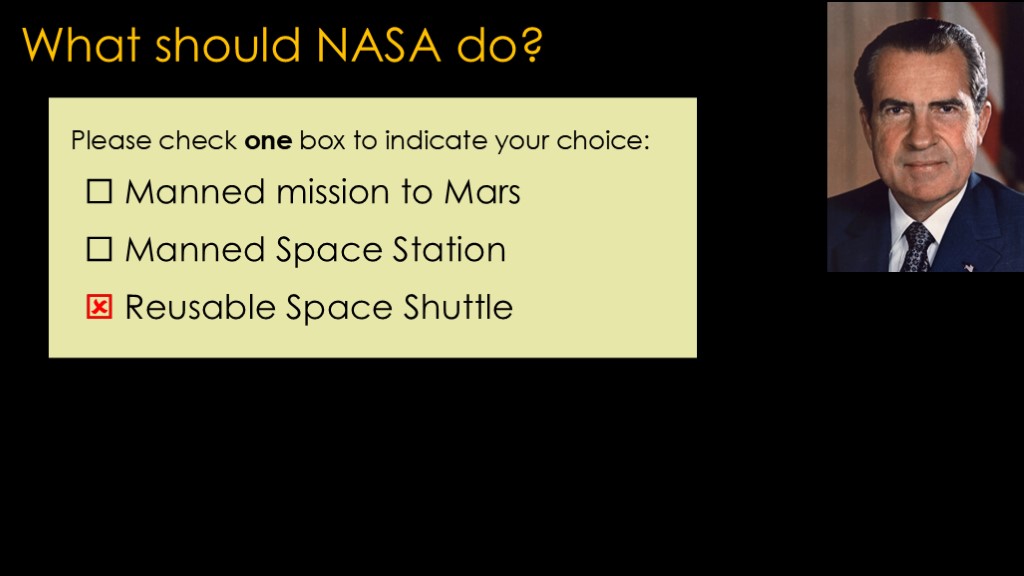
There a story from this time that president Nixon was presented with three options for NASA going forward:
A manned mission to Mars, a manned space station, and reusable space shuttle, and he chose the shuttle.
It's pretty clear that that story is not true.
There was no way that a mission to Mars would happen. It would be more costly than Apollo, and there was zero chance that congress would allocate money for that mission.
A space station was also out, because with the cancellation of Apollo, NASA had no way to get crew to a Space Station.
Which means the shuttle was the only choice, but it took a long time for Nixon to decide to go ahead with it. NASA had their shuttle program, but the space station would have to wait until some time in the future.
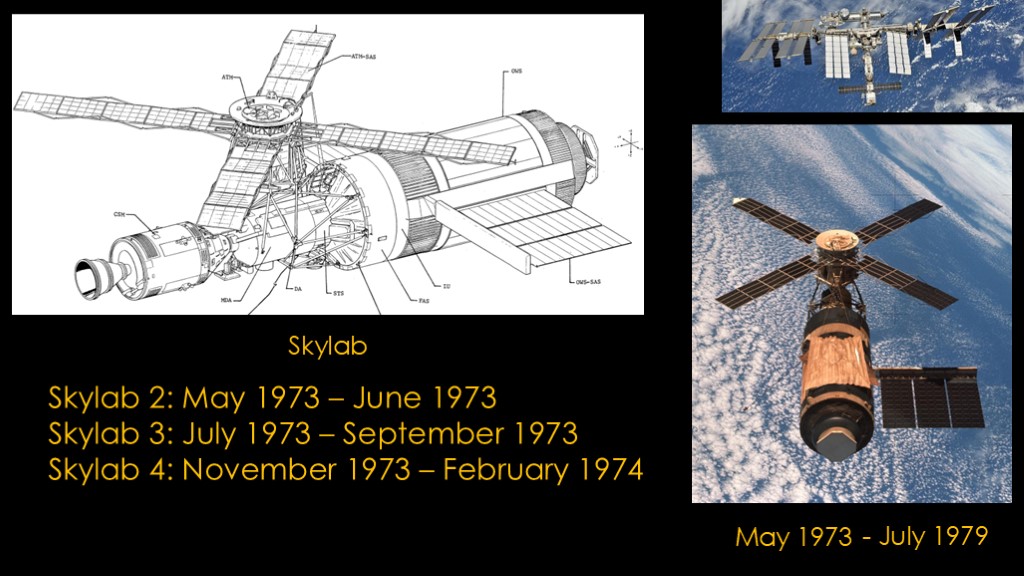
NASA did get something out of the cancellation of Apollo.
There were leftover Saturn V rockets and a number of Saturn IB rockets and Apollo spacecraft.
NASA eventually came up with a design for a station they named Skylab, which was built inside the third stage of one of the surplus Saturn V rockets. It was launched into orbit in May of 1973.
There were three missions flown to skylab, confusingly named skylab 2, 3, and 4 since the launch was named Skylab one. There was a fourth mission scheduled for spring of 1974 but it was cancelled.
NASA had plans to reactivate skylab when shuttle was flying, but a combination of shuttle delays and increased solar activity resulted in skylab reentering the atmosphere in July of 1979.
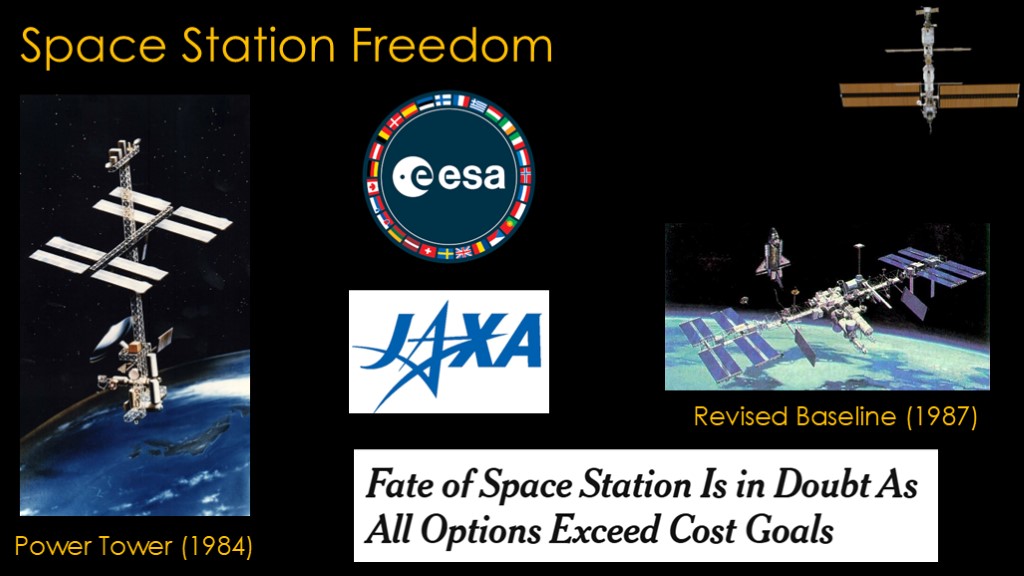
NASA was still planning a space station, which would be named "Freedom".
The Power tower configuration was announced by President Reagan in 1984, but - as we know - presidents don't control NASA's budget, congress does, and congress was not impressed.
Three years later there was a revised baseline, and in the meantime NASA had recruited the European space agency and Japan's JAXA to participate, but as the projected costs kept increasing congress was unwilling to fund the program. NASA needed a way to reduce the costs.

The solution came from a very unexpected source.
In December of 1991 the Soviet Union officially dissolved.
The Soviet - now Russian - space agency Roscosmos now had their own problem
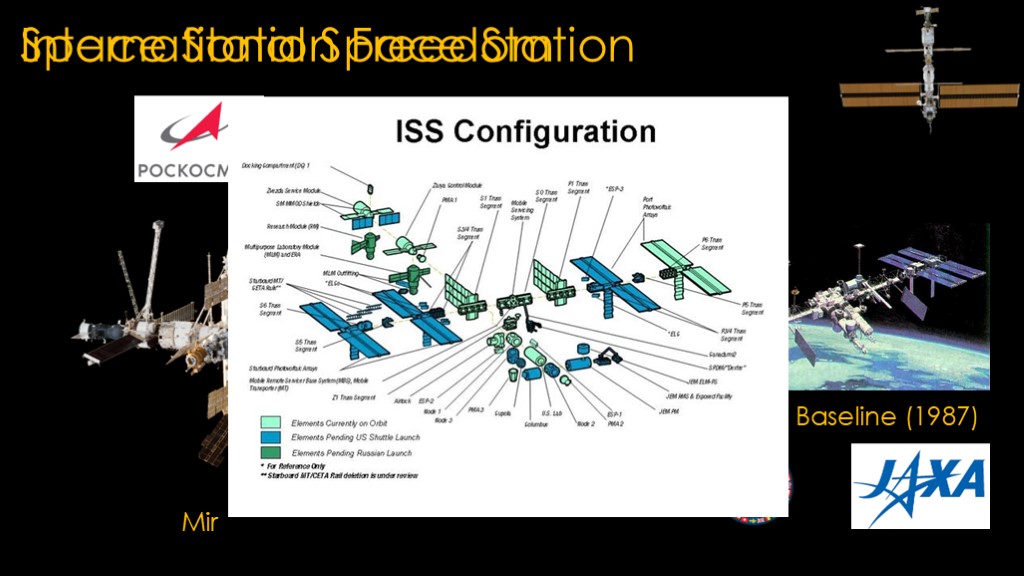
They had been planning for many years to launch an updated space station to replace the aging Mir station, but they now also had monetary issues.
Take the Russian plans and the US/European/Japanese plans, put them together, shake well, and you end up with the international space station.
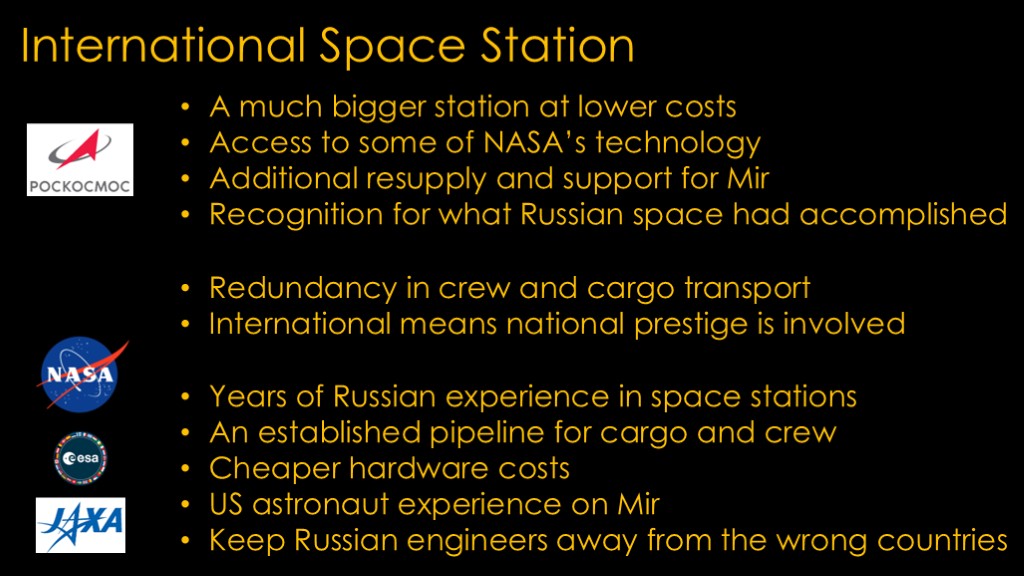
This was truly an excellent idea.
The Russians would get:
a bigger station at lower costs
access to some of NASA's technology
Additional resupply and support for Mir until the ISS could be launched
Recognition for what Russian space had accomplished in the years since Apollo.
NASA/ESA/JAXA would get
Years of Russian experience in space stations
An established pipeline to carry crew and cargo to the station
Cheaper hardware costs
The opportunity to get US astronaut space station experience on Mir
A way to keep Russian aerospace engineers doing things that the US liked rather than working for countries the US didn't like.
Both groups would get:
Redundancy in crew and cargo transport
An international program, which means that national prestige is involved making it harder for either participant to back out.
There's another US benefit that is less obvious.
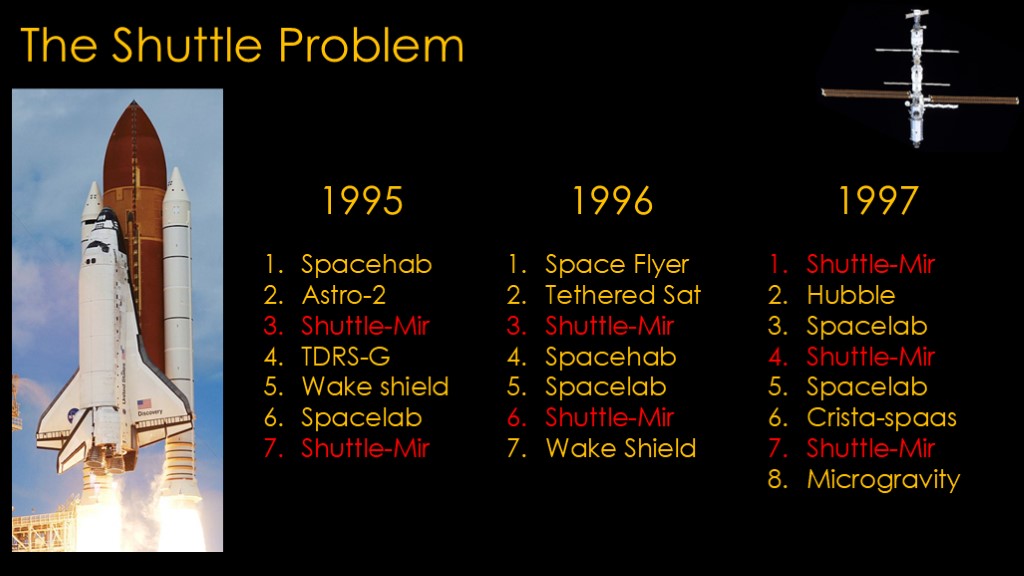
NASA had a shuttle problem...
Originally, the shuttle was going to be flying all the time, but post-challenger it wasn't going to be launching commercial satellites and over time the DoD wasn't really interested either.
If we look at the shuttle manifests, they flew 22 times in 1995-1997, and 7 of those are flights to Mir as part of the ISS agreement, so it's clear that the manifest is pretty thin.
If we look at what shuttle did *after* ISS assembly started, it's a bit more clear.
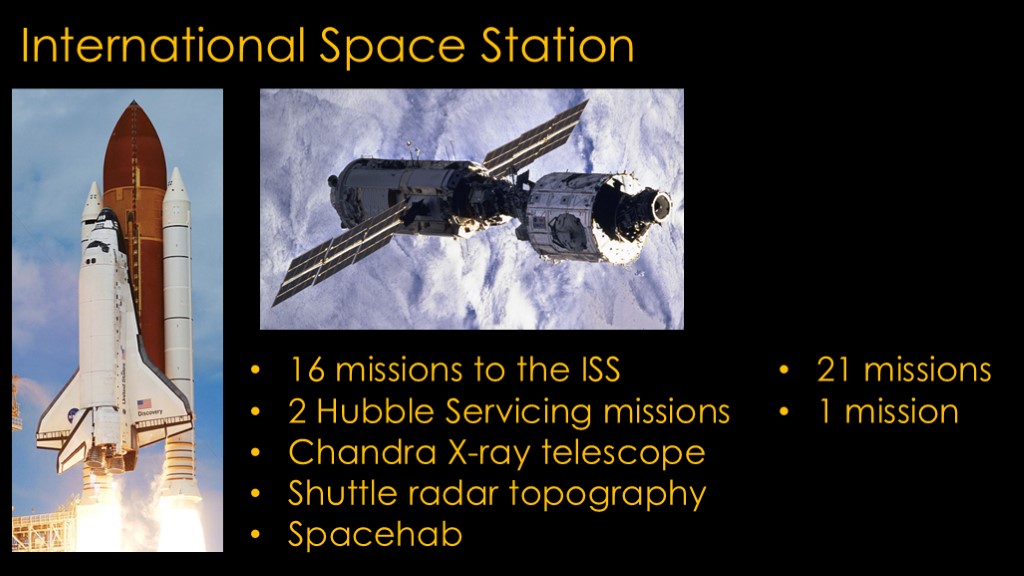
From the start of ISS assembly in late 1998 until the loss of Columbia in 2003, shuttle flew 16 missions to ISS, 2 to service hubble, the launch of the Chandra X-ray telescope mission, and radar topography mission, and the last flight of Columbia, a spacehab mission. That's a full 75% of the missions dedicated to ISS, and 3 of the 5 non-ISS missions were flown on Columbia, which could not perform ISS missions because it was heavier than the other shuttles.
After Columbia, all the remaining shuttle missions were to the ISS, with the sole exception of that last hubble servicing mission.
I have talked a lot about why shuttle was cancelled in the past, but it wasn't until I looked at the manifests closely that I realized that one of the reasons was that the only big mission left for shuttle was delivery of cargo and crew to ISS and it was a very expensive way to accomplish that. All the shuttle infrastructure was sized to fly about 8 times a year, and flying only a few times a year would cost about the same overall, bumping the per-flight cost up significantly.
And that's the story of how the international space station was created.
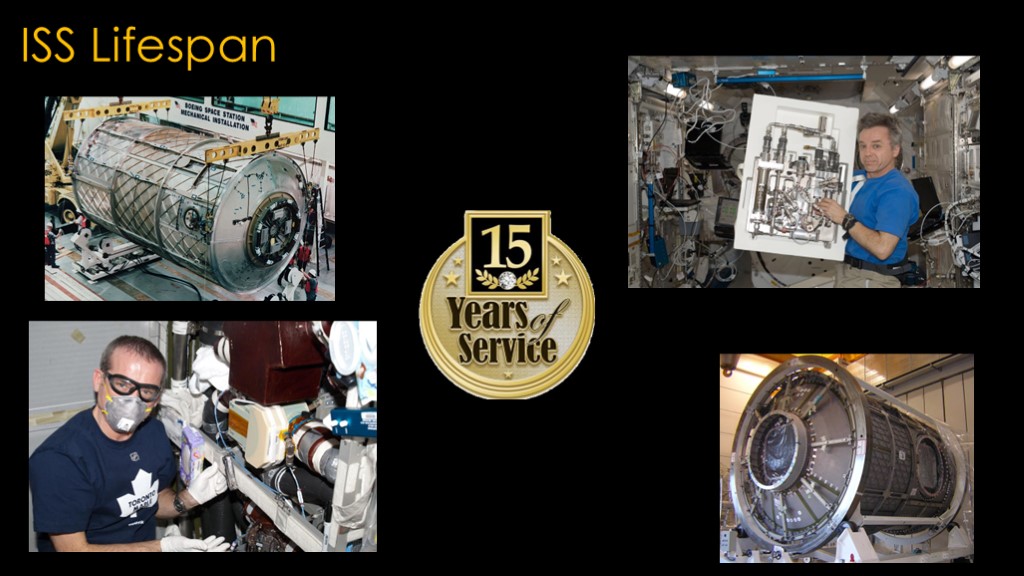
The ISS modules were originally designed to last 15 years, and we know that NASA has robust designs and can therefore expect that they will last longer with proper maintenance. We are at 26 years for the first modules.
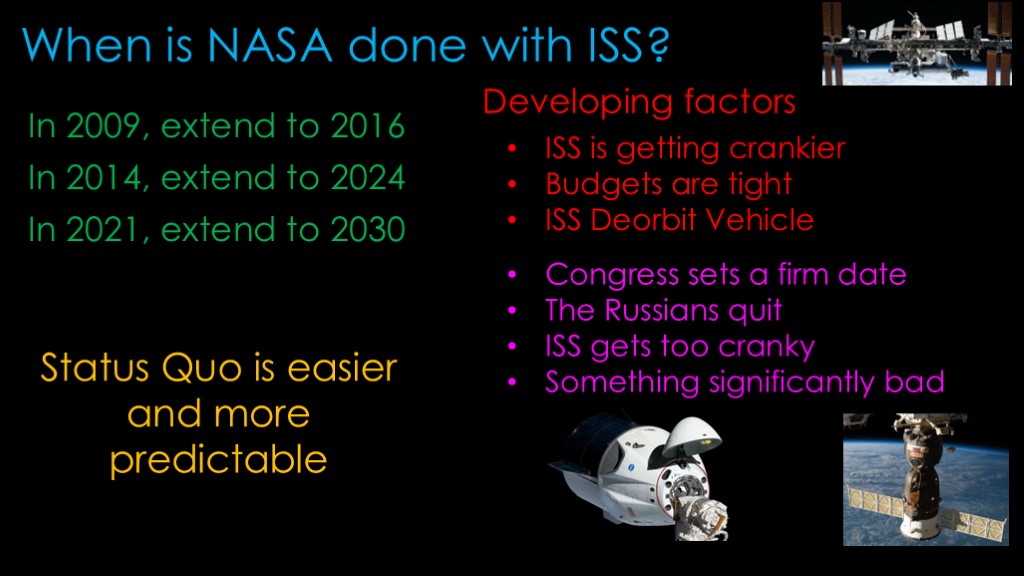
At some point, NASA will be done with ISS. When will that be?
There's already a well-established pattern...
In 2009, ISS was extended to 2016, in 2014 it was extended to 2024, and in 2021, it was extended to 2030. The big reason for this is that maintaining the status quo is easier and more predictable for everybody - everybody at the NASA centers, the contractors, the politicians in states that benefit from the program, and the international partners - all know exactly what keeping the current program for another year will entail. This is a very powerful force - there's a reason NASA flew shuttle for 30 years - and I would not be surprised at all to see them extend beyond 2030. There are NASA studies that are exploring that option.
On the other hand, there are developing factors that are becoming more prominent
The station is getting crankier, with more ongoing problems. Air leaks in the Russian segment have become persistent and so far have resisted attempts to fix them.
With Artemis becoming more real it is asking for more funds and additional money for NASA from Congress seems unlikely.
NASA has actually come up with a deorbit plan and given SpaceX a contract to develop a deorbit vehicle, though it is not fully funded.
How will these two sets of forces balance out?
I don't think the decision will be based on a date; as long as station is functional enough it will be extended.
The decision will come from other factors, and I see a few likely possibilities:
Congress could set a firm date and say "no more money after that". The status quo argument says this is unlikely to happen, but political winds are always hard to predict
The Russians could quit. The function of the Russian segment and the materials that come up through progress resupply and the reboost are critical without some quick thinking on NASA's side, and AFAIK there is no contingency plan. It's not clear how likely this is; the ISS is pretty much all that Russia has left of their space program but they could chose to spend money elsewhere.
The station may become that old car that you are putting $500 into every month and you can no longer rely on it to do what you need it to do.
Something significantly bad happens - there's a big debris strike, a critical system breaks down, there's a hazardous fluid leak - and the astronauts and cosmonauts have to get in their capsules and head for home. That could easily be the end for human habitation of station.
My guess is that it will be one of those. Let's hope that it doesn't take killing astronauts or cosmonauts for the decision to be made.
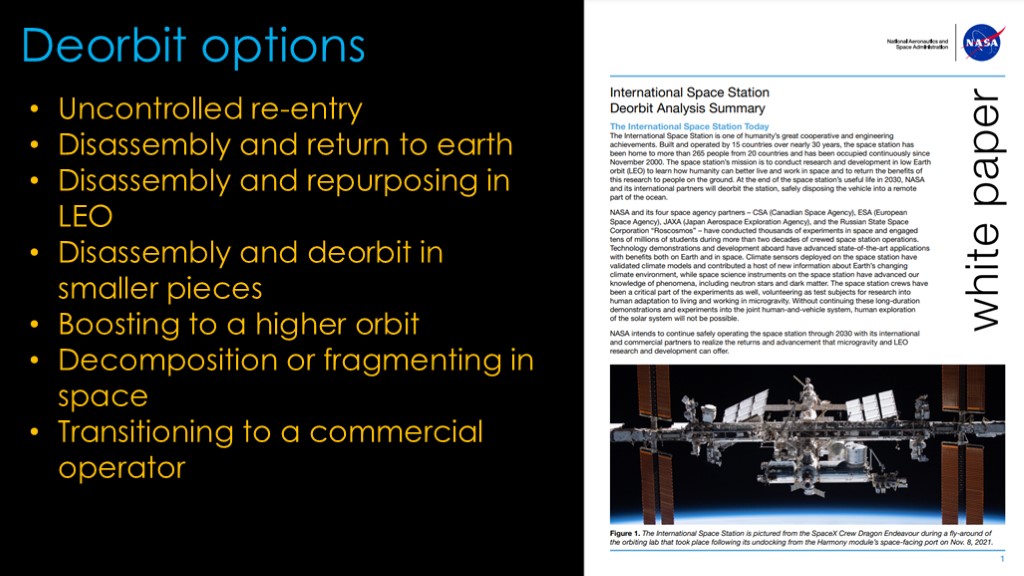
NASA's plan of record is to deorbit ISS.
Why are they doing this? Isn't there a better alternative?
NASA did a detailed analysis of 7 alternatives and summarized them in this white paper.
The alternatives are:
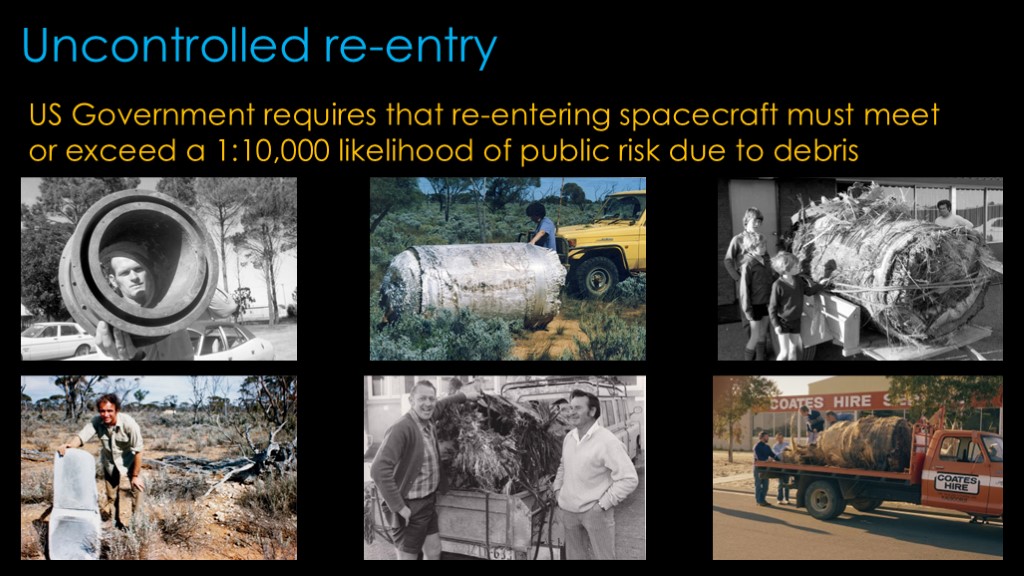
There is a government standard that says you can only do uncontrolled reentry if you can show that there is less than a 1 in 10,000 likelihood of public risk.
In 1979 when Skylab reentered, it missed the planned disposal location in the Indian ocean and instead dropped all around the port town of Esperance in western Australia.
Skylab had a mass of 76 tons, and the ISS has a mass of 400 tons. "Hope it doesn't hit anybody" isn't a responsible strategy.

Three of the options would require disassembly.
There are no disassembly instructions available.
It might appear that one could just take the assembly order and perform it backwards, but remember that the station has to remain operational and habitable at every step in taking it apart, and it has been modified over the years to make that more complex than you would think.

There is this weird thing called "cold welding", where metals that are in contact in vacuum will spontaneously bond to each other. Some of the space station modules have been held together for 25 years; they may not want to come apart.
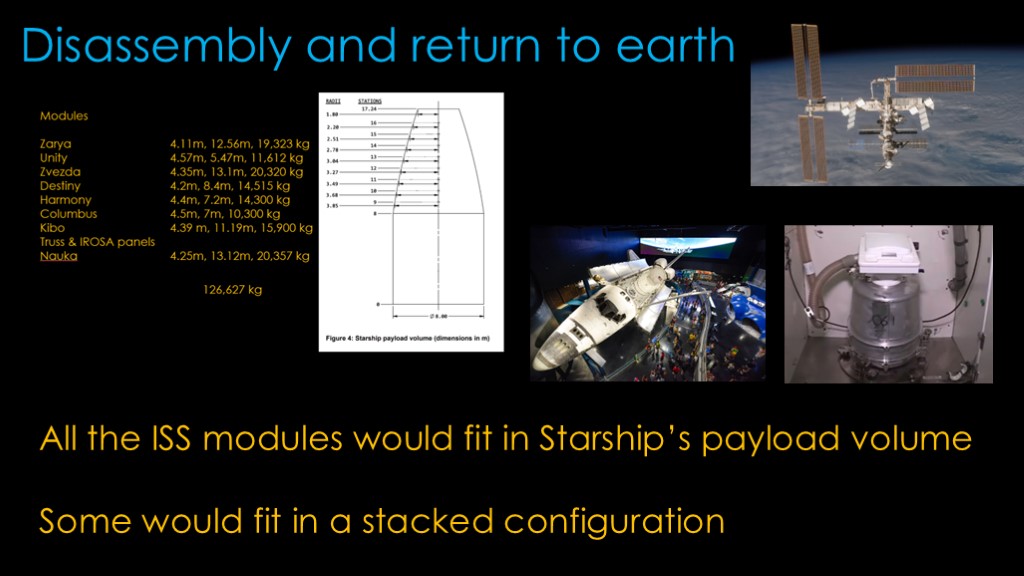
Disassembly and return to earth.
I actually started a video on doing this with starship called "bring ISS Home", but then this report came out and I lost interest.
I did do some calculations using the dimensions of the modules and found that you can fit them within starship's payload volume, and with some modules you could stack them and return them together.
It would probably take about 6 missions and you'd probably need a custom starship.
And then once you get them back you would need to decide what to do with them.
This is one of the Space Shuttles that NASA flew into orbit is a very impressive sight.
This is the space station toilet is a little bit less impressive.
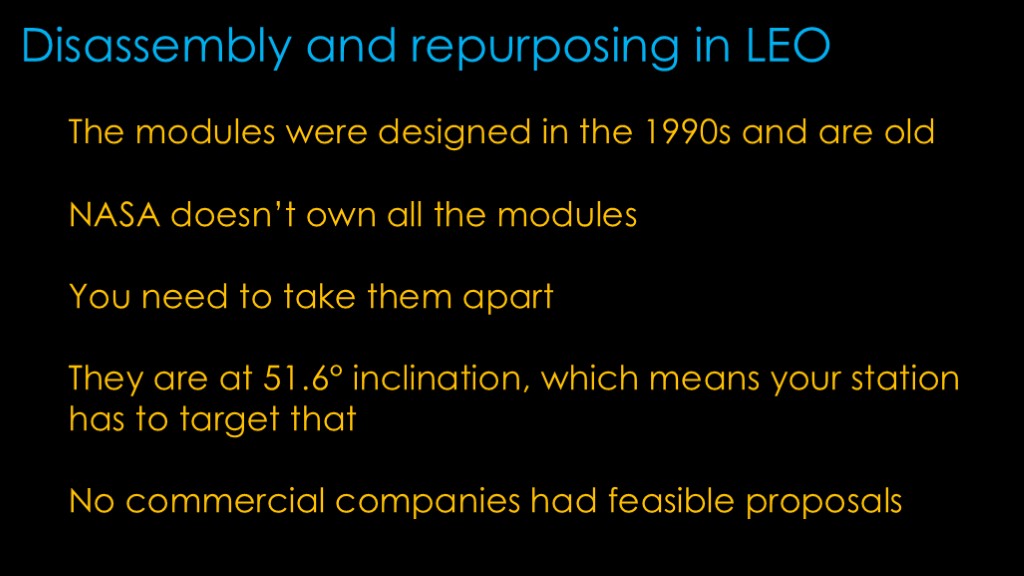
Reuse sounds like a nice plan.
However...
The modules were design in the 1990s or earlier and are old
NASA doesn't own all of them
You need to figure out how to take them apart
Their orbit is at 51.6 degrees of inclination, so you are stuck there, and it's more costly to get there than the 28.4 degrees native inclination you get from cape Canaveral. Unmentioned is the fact that station is at 51.6 degrees because it needed to be there so the Russians could access it, and nobody in the US is going to touch working with them on new projects in the foreseeable future. It *is* true that the higher inclination covers more of the earth's surface if you care about that.
And finally, no commercial companies had feasible proposals
These are all good reasons, though the last one need a caveat:

The caveat is that Axiom space has an ongoing project where they will build one or more modules and connect them to ISS, and then when ISS is decommissioned, those modules will convert to a free flyer.
NASA has kicked in some pocket change with a firm fixed price contract for up to $140 million over 5 years.
If you can't place the name, Axiom is the operator for the Crew Dragon missions that visit the ISS, and they also have the contract to build the Artemis Lunar spacesuits and - presumably because Collins Aerospace has dropped out - future space station suits as well.
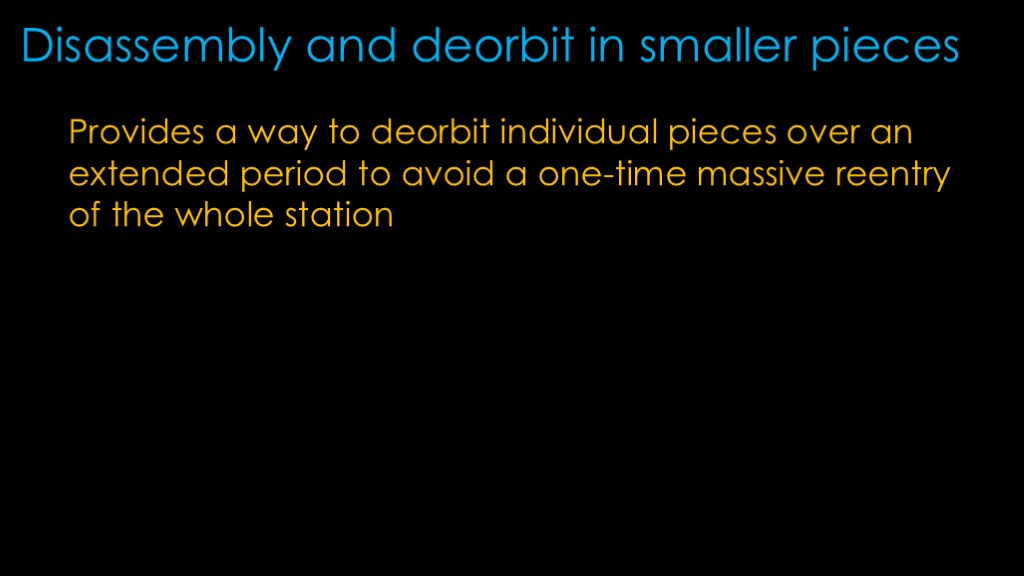
Disassemble and deorbit in smaller pieces.
The benefit of this is (read)
The downsides are the same as the other disassembly options, plus the requirement for a number of deorbit tugs rather than one big one.
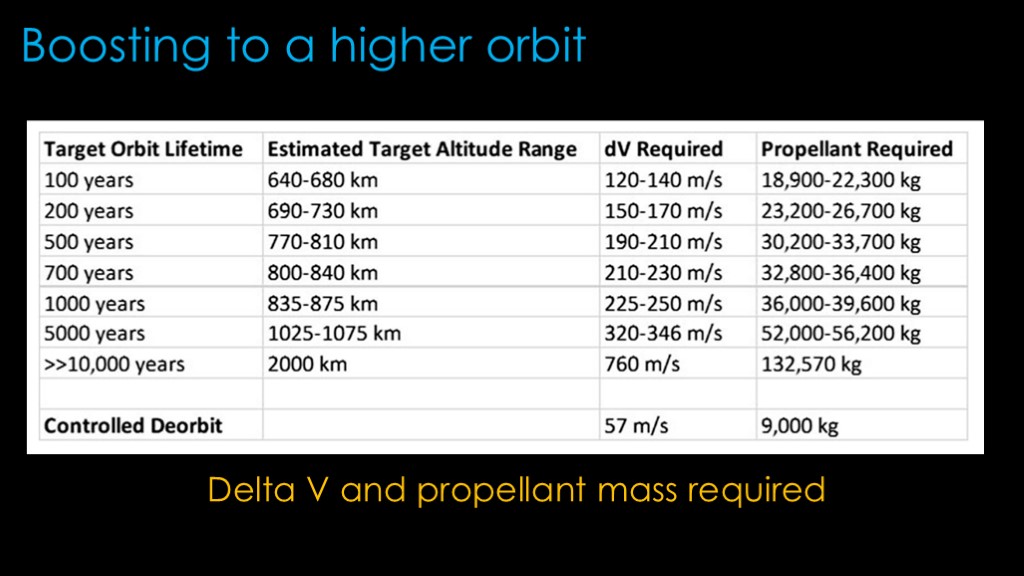
Thanks for sitting through all the optinos up until now; we have finally reached the one you are waiting for, boosting to a higher orbit.
NASA has done a really good job with the explanation in this section.
We start with this chart that shows the delta V and propellant mass required to move ISS to a higher orbit. None of the current launchers can carry that sort of propellant in a single launch when you include the mass of the boost ship. Maybe you can get there with a heavily modified Falcon Heavy, or perhaps with a New Glenn.
NASA mentions starship as an option, and it could certainly do the job, but you would need to modify it to be able to give enough thrust to ISS without tearing it apart. A single raptor may be too much thrust.
NASA also talks about Solar Electric propulsion. That only takes 15 tons of propellant to get to 850 kilometers, but it also takes 3 years and you need to keep station operational for that whole time period.
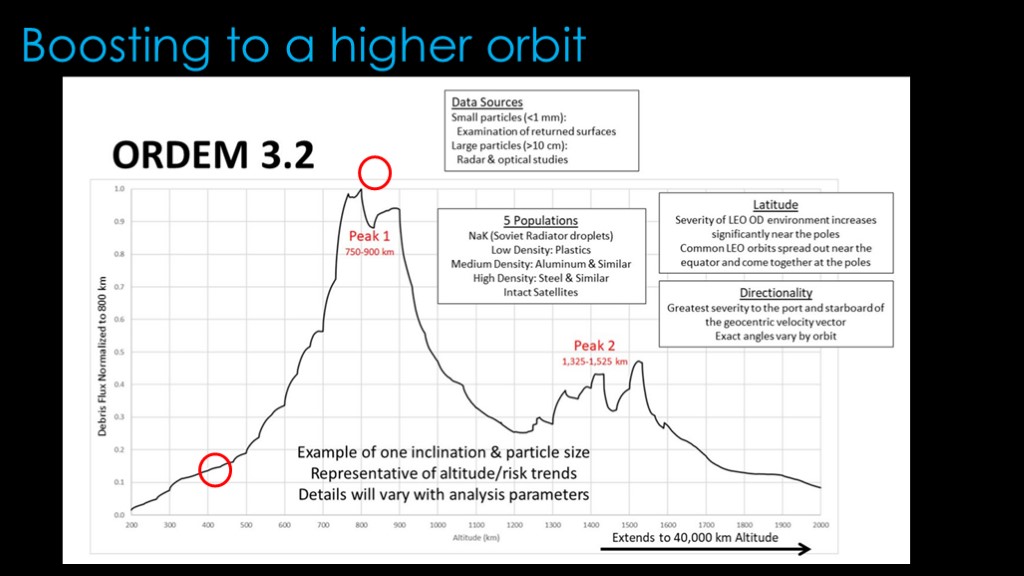
NASA has an orbital debris model known as ORDEM that can be used to predict the amount of debris at specific orbital altitudes.
Station lives down here, at a little more than 400 km. At that altitude, ISS has to perform about 1 debris avoidance maneuver per year. If there isn't time to maneuver, the astronauts and cosmonauts move to their capsules and wait for the danger to pass.
A 1000 year orbit has a debris flux that is 6 to 7 times worse. And remember that you would be putting it there without the ability to dodge debris.
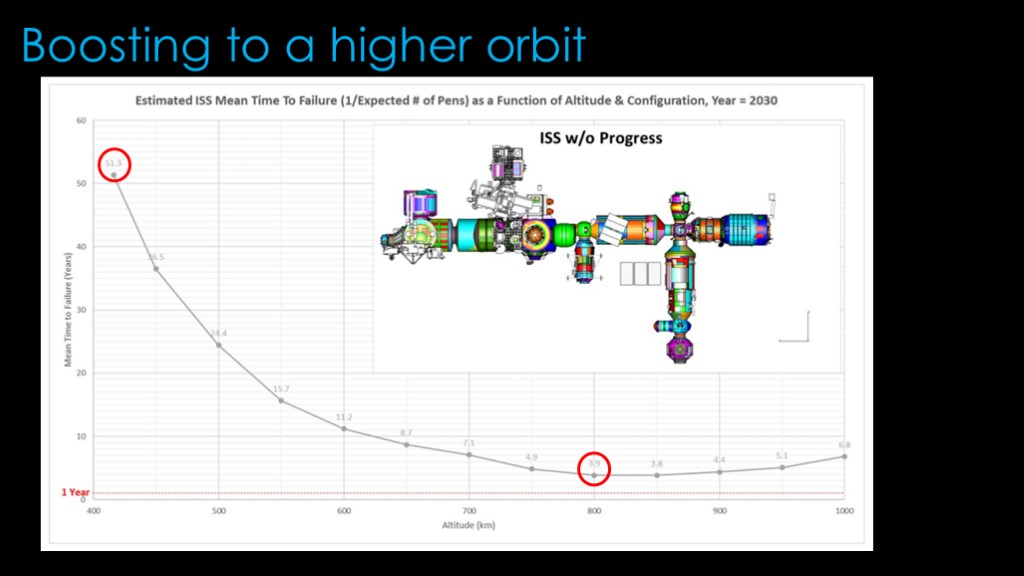
Here's a scary picture...
At the current altitude, the estimated mean time to failure for ISS due to debris strikes is 51.3 years.
Bump it up to 800 kilometers, and that number drops to 4 years.
ISS is a huge target, and if you put it at 800 kilometers, it is going to get hit and those hits are going to generate fragments that increase the debris risk, and more of those new fragments are in long-term orbits.
I don't generally think that Kessler syndrome - where you get so much junk in low earth orbit that it creates a self-perpetuating debris cloud - is a major risk, but putting ISS at 800 kilometers is probably the worst thing you can do when it comes to space debris.
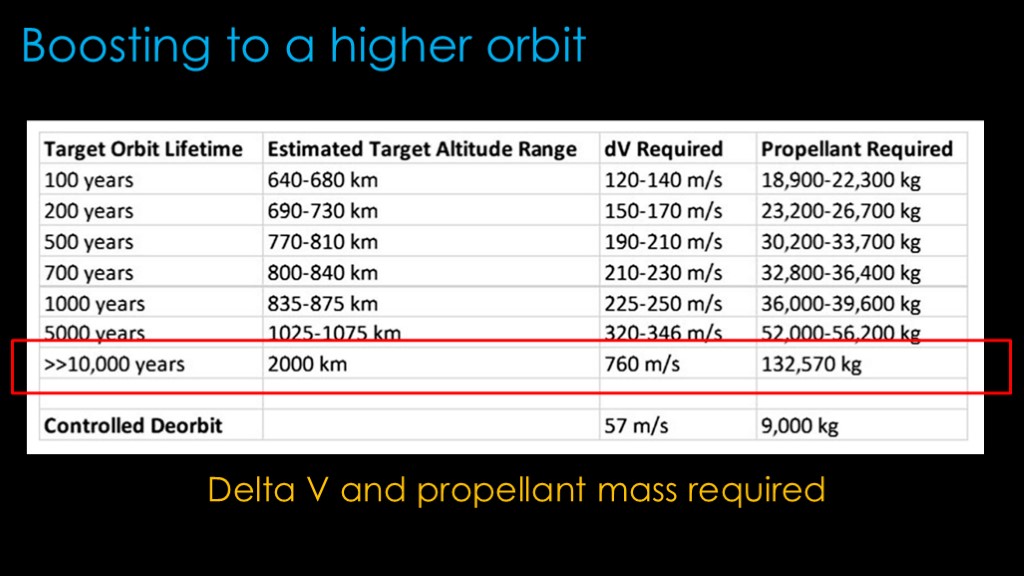
If you get out to 2000 km you start getting back to the low risks sections, but it's not a no risk area - station still has to do active avoidance at that density - and you really need starship-class tugs to move it there.
At this point you should be asking "what's the point of trying to preserve ISS in a higher orbit if the debris is just going to tear it apart?"

I have no idea why NASA included this as an option - deliberately creating space debris even at low orbits is a pretty dumb idea - but my guess is that somebody thought it was a good idea and NASA therefore decided to include it.
I'm not sure how you would actually do this, but even if you could, some of the fragments are going to end up with more energy and in higher orbits.
This is the second-worst option, and it's only second because the previous one is so bad.
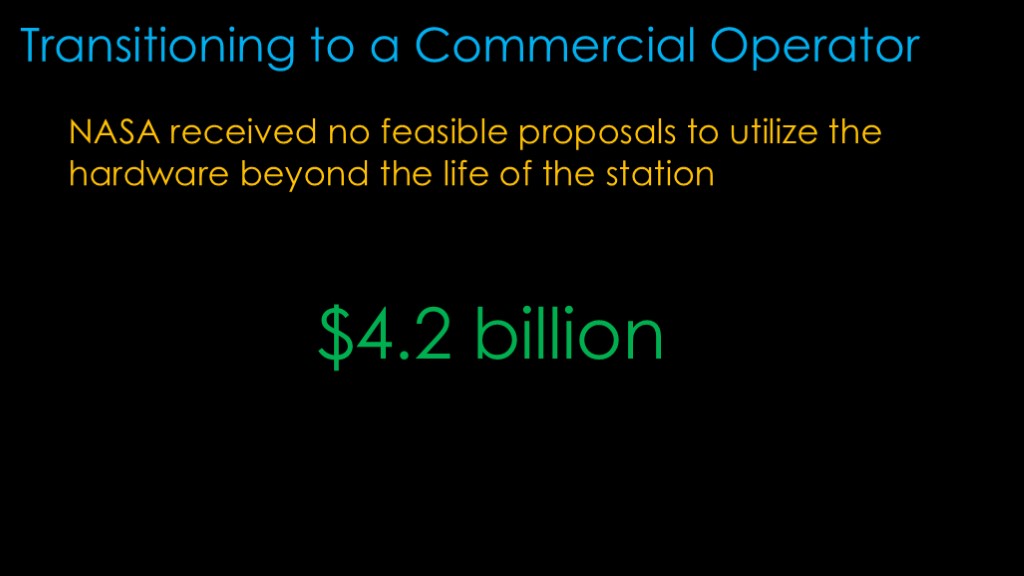
Transitioning to a commercial operator.
NASA notes that they had discussions with the US industry in regard to their interest in repurposing any parts of station or taking over operation, and they received no feasible proposals.
NASA is currently spending $4.2 billion per year on ISS. You need to cover that, either convince the Russians to keep working with you and flying Progress missions or come up with your own reboost and attitude systems and detach the Russian modules. In return, you have to figure out how to bring in enough money to make the investment worthwhile.
I don't see any world where that would make sense, and the industry agrees.
And that's why NASA plans to deorbit ISS; none of the other options are workable.
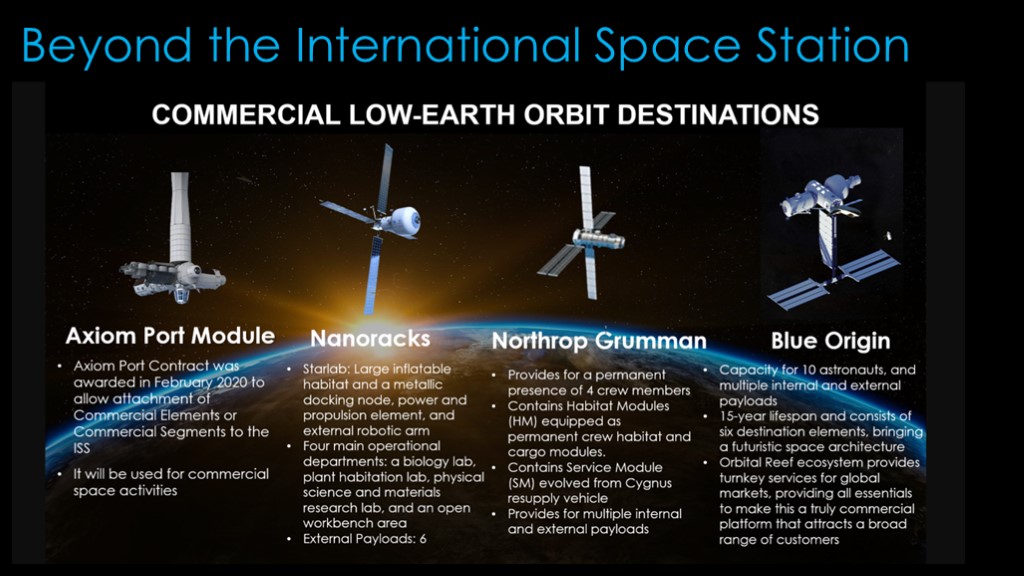
What comes after ISS?
NASA's current plan is known as commercial low earth orbit destinations, or commercial leo.
Commercial companies will build and operate space stations and NASA will buy space station time from those companies.
I'll cover that in detail in a future video
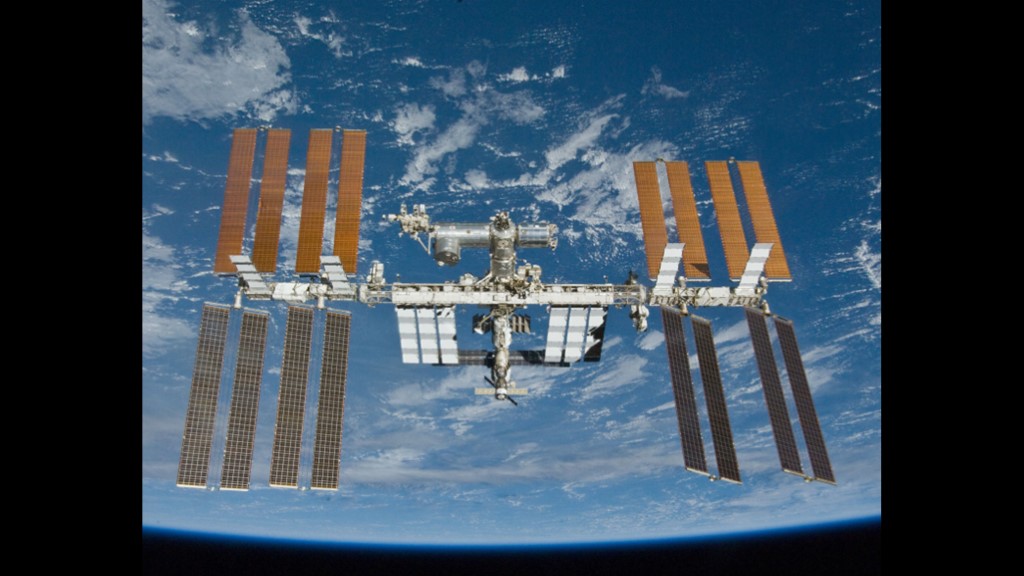
And that's the rise and impending fall of the international space station.

If you liked this video, please send me this surf beach 17 foot dual lane water slide featuring a splash pool at the bottom, currently available for only $234 dollars a month.


I've been asked a few times whether I think the ISS was worth it.
To do that, we'll need to do a cost/benefit analysis to weigh the cost of ISS versus the benefits that we got from.
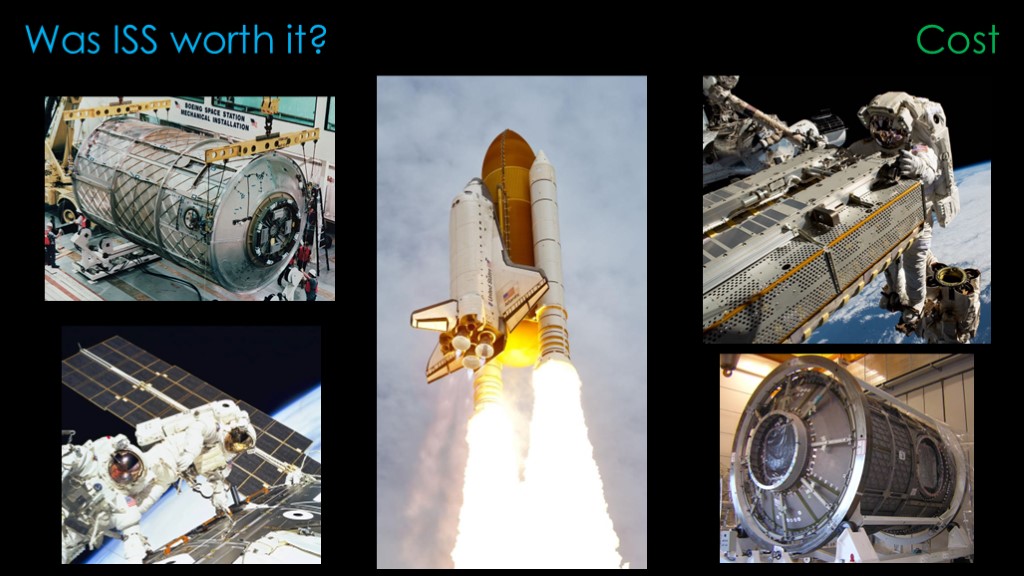
We'll start with cost.
Every part of the ISS is custom made for the ISS program to meet the needs of the program, to last for 15 years in the hostile environment of space, and to be as light as practical.
The majority of these parts are carried into space on a shuttle flight that costs perhaps $500 million a flight.
The parts are then very carefully assembled by highly trained astronauts.
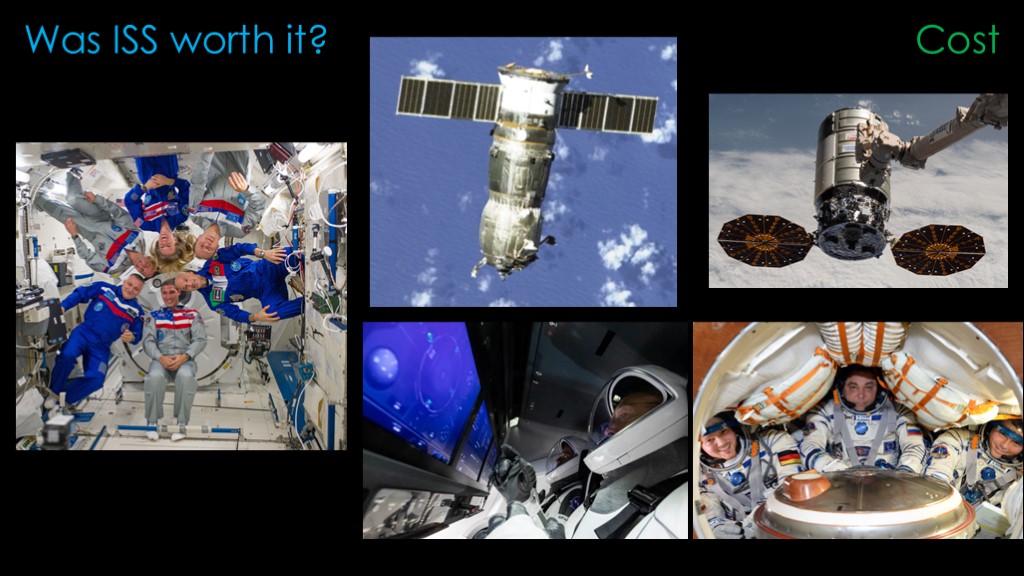
The astronauts and cosmonauts that make up the ISS expedition crew tend to get a bit cranky if they don't have air to breathe, water to drink, and food to eat, so the station requires a constant stream of cargo vehicles to bring up consumable and take away waste, along with crew vehicles to bring up new crew members so the old ones can return to earth.
That is not - unsurprisingly - a cheap thing to do, so there's a lot of cost there.
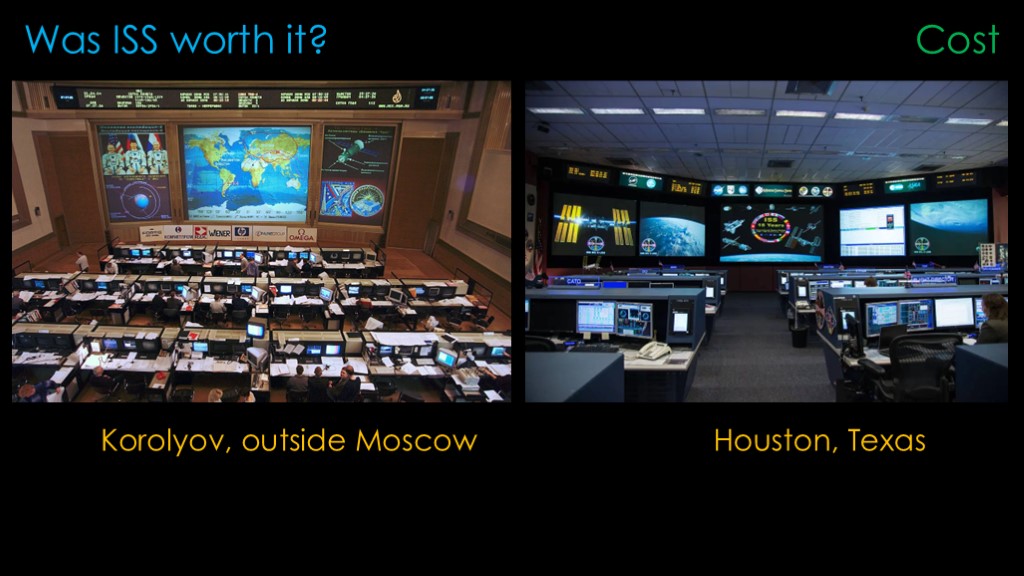
And there are two control rooms that are continuously staffed, the Russian one in Korlyov (car-la-yov) outside Moscow and the NASA one in Houston Texas.

Add all that up, and you get $100 billion.
Actually, you get a bunch of people each with their own number, but $100 billion is the right order of magnitude and that's all we need to answer the question.
We now know the cost.
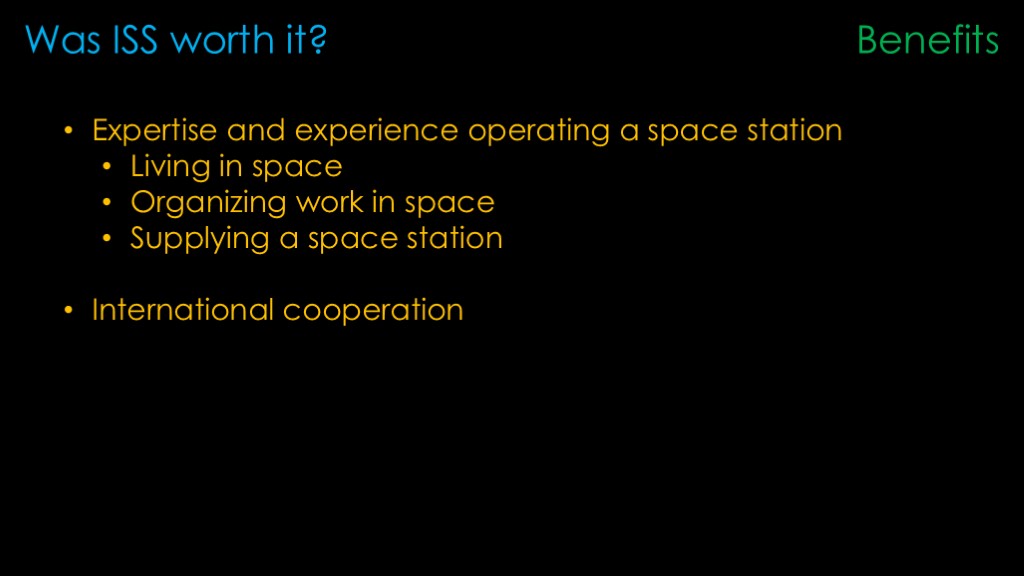
Now we can look at the benefits.
I'll note that there's an implicit question that comes out of the cost/benefit analysis which is "what could we have done with the money if we didn't do ISS?" "Stuck in LEO"
The first benefit is pretty obvious - ISS has taught us a huge amount about what it takes to actually operate a space station, and much of that applies to other situations - lunar bases, mars missions, and mars colonies. It's quite useful learning your lessons in LEO rather than in a location that's much farther away.
The second thing is international cooperation in space. More countries cooperating in space is a good thing, and the ISS model has been transferred to the Artemis accords.
In the present day, US and Russian relations are about as frosty as they have been since the collapse of the Soviet Union, but both countries are still sending both crew and cargo to the station and still flying on each other's rockets to get there. Putin removed Roscosmos head Dmitri Rogozon 2022 when his anti-western position was threatening the cooperation in the space


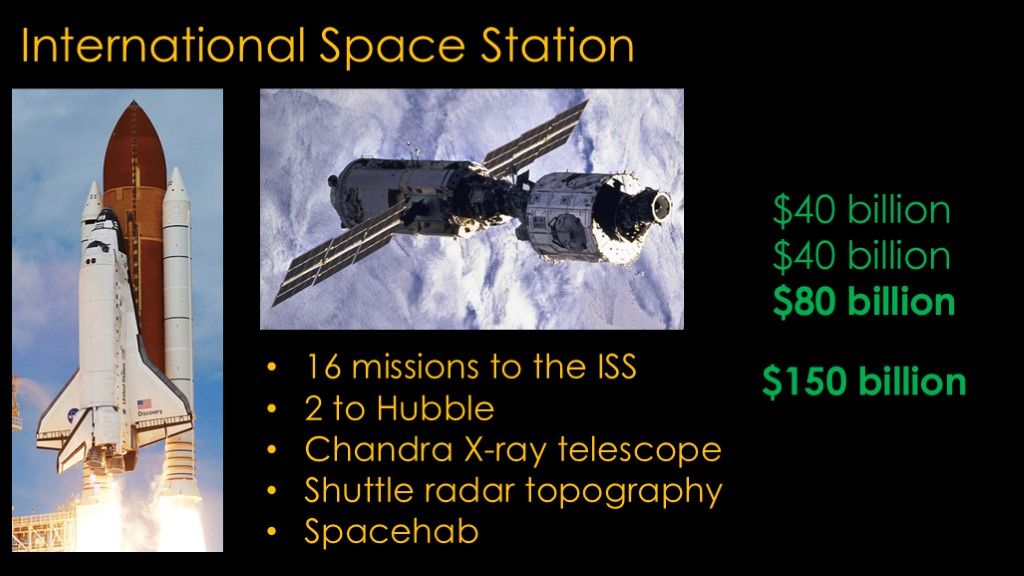
From the start of ISS assembly in late 1998 until the loss of Columbia in 2003,
Chandra (Columbia)
to the end of the program, shuttle flew 37 missions to the ISS, 3 to hubble, and 3 other missions.
Shuttle existing almost purely to put the space station together, and one of the reasons it was cancelled was that it had finished assembly of the space station and there was no other good job for a vehicle that cost $4-5 billion per year.
People often ask about how much ISS cost to build, and since nobody could agree on the costs during the program it's hard to find good numbers now. A conservative estimate for the cost of the modules is $40 billion and the cost of the shuttle flights is about the same, so I'll say $80 billion for the US contribution.
Other people have estimated that the total cost across all the countries is closer to $150 billion.
Either way, ISS is probably the single most expensive thing ever built, and that explains why NASA keeps extending it.
Well, not really. Remember that NASA walked away from all the Apollo stuff and later walked away from all of the shuttle era stuff.
It really comes down to politics.
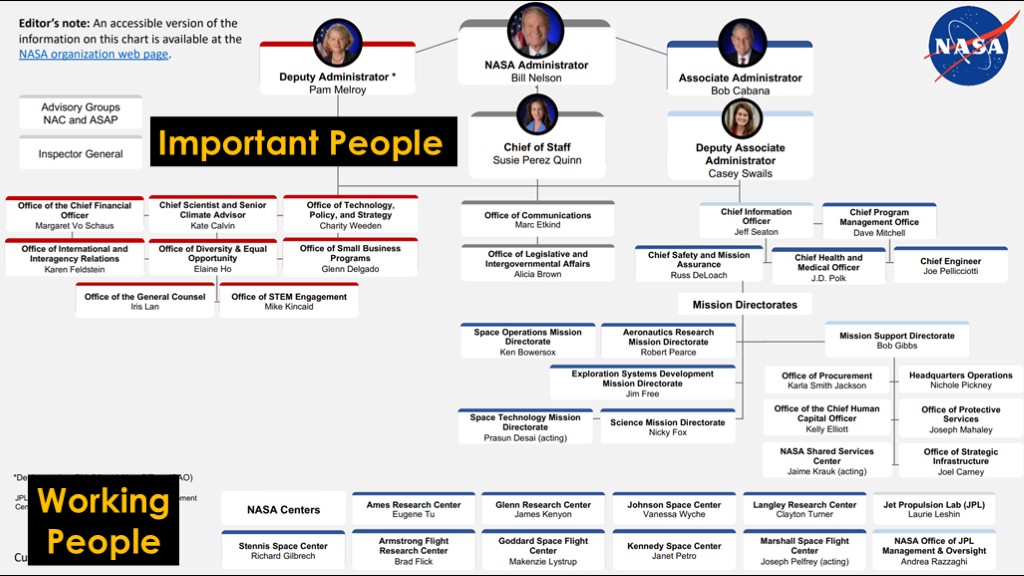
To explain I'm going to need to inflict on you the current NASA org chart, which looks pretty typical if you've seen corporate org charts. It has the important people at the top, and the working people in the NASA centers at the bottom.
I've recently realized that this is the wrong way to look at NASA, and if you look at it this way, you'll ask lots of "why don't they just?" questions.
I have a new model that I hope is more enlightening.
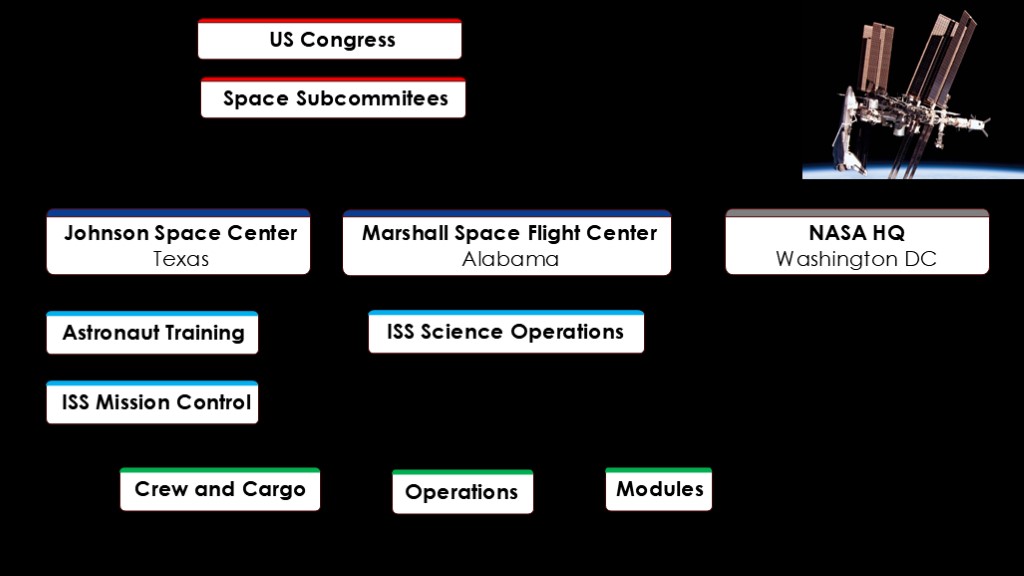
The way I would draw the org chart is a view that puts the NASA centers in the middle.
For ISS, the most important NASA centers are Johnson Space Center in Texas and Marshall space flight center in Alabama.
They get their marching orders from congress, specifically from the space subcommittees, and they also get the money to support those programs from congress.
Johnson's big part of the pie for ISS is astronaut training and ISS mission control, and Marshall's is ISS science operations, though Marshall have worked on building ISS modules in the past.
Below that are the contractors that handle the transportation of crew and cargo to and from station, those that manage operations on station, and those that build or have built modules for station.
The drivers for the politicians deciding which NASA missions get funded are the benefits that it brings to them and their constituents, so the money that goes to the NASA centers in their states and the contractors wherever they may be located.
What this means is that the NASA centers are the drivers of what happens because they have the connections that control funding, and NASA HQ mostly plays an organizational role off to the side.
Let's ask some questions and see if this model helps answer them...
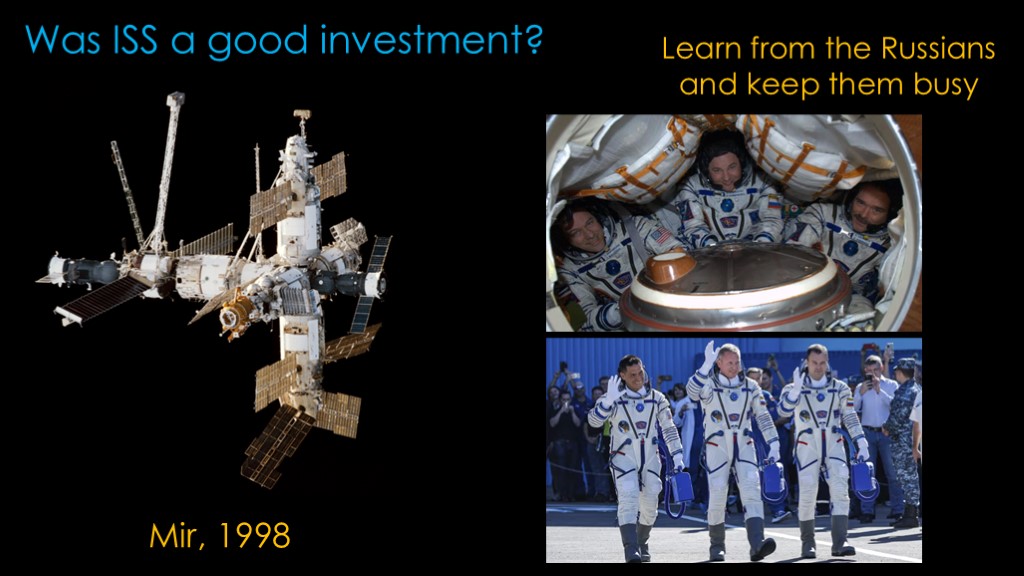
Learn from the Russians and keep them busy.
The Russians had serious amounts of on-orbit experience that the US lacked and that was the point of both the shuttle visits and the seven NASA astronauts who carried out long-duration missions on Mir. And the Russians brought that experience to the space station, and their participation was critical during the time period between the retirement of shuttle and the first SpaceX crew dragon flight - without the Russians, the space station would have been uncrewed for 9 years.
The second goal was to keep the Russians busy working on space station stuff rather than leaving to work on rocket projects in countries that might not be friendly to the US.
It's fairly clear that the endpoint between the Russians and the US in space isn't what we had hoped for, but I would argume that it worked pretty well for quite a few years.
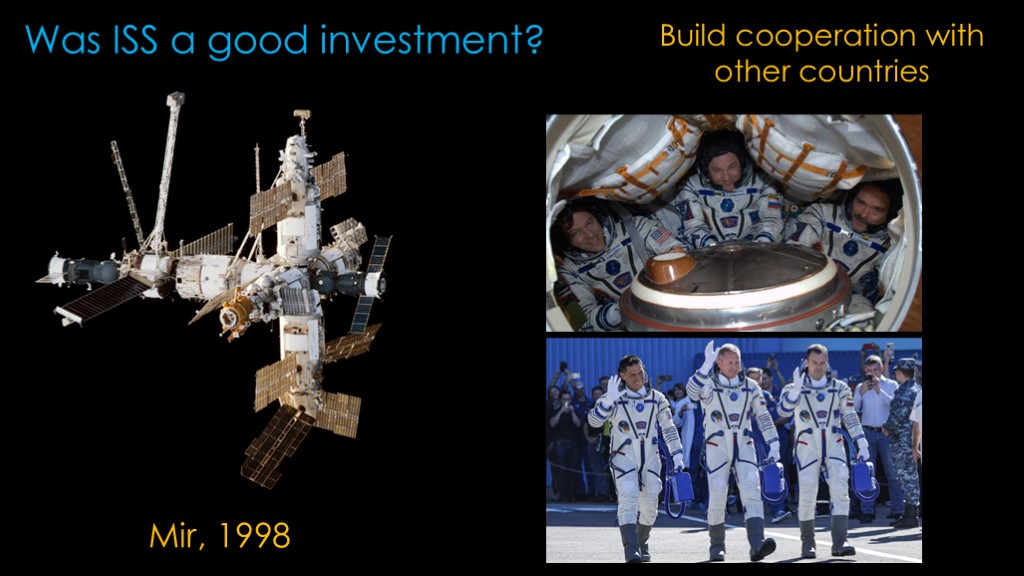
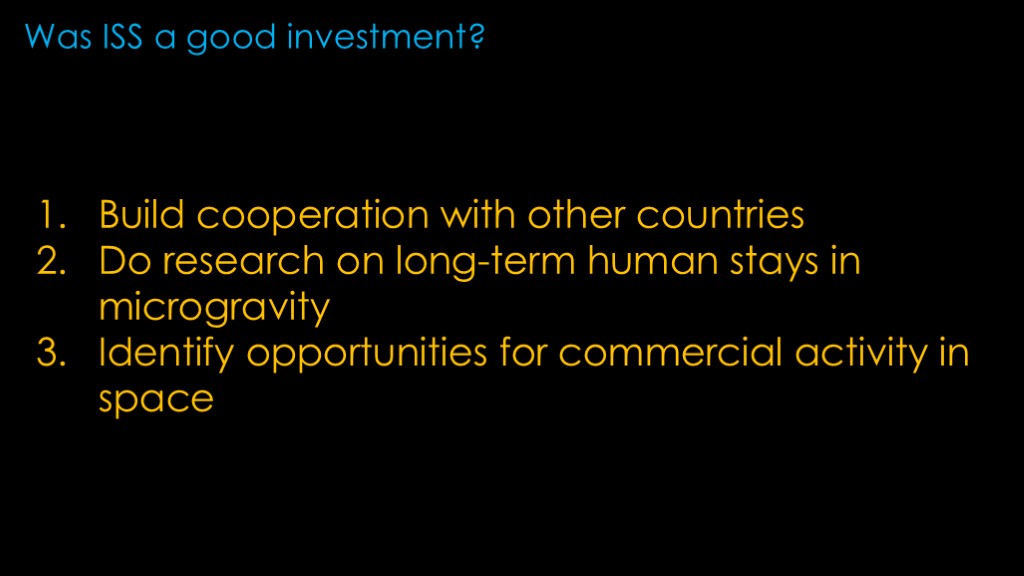
I was asked a while back whether ISS was a good investment.
This is complicated because the answer depends on what you think the purpose of the space station should be, and that differs from person to person. I'll give a list of what I think the goals are for the space station and whether they accomplished them.
The first two are the ones I already talked about - keeping shuttle busy and keeping NASA centers busy. It did a good job at both, and from NASA's perspective, those were important.
Keep the Russians busy. The idea was that keeping Russian aerospace engineers working on peaceful space things was better than turning them loose to work on other things, and that's why the US paid for the construction of the Zarya module. It was also to bring the astronaut and cosmonaut community and their group training communities closer together. I would say it achieved all of those, and though the situation in Russia isn't what we had hoped it would be, that doesn't mean that the effort wasn't worth it.
Cooperate with other countries. In addition to Russia, JAXA in Japan, CSA in Canada, and all of the ESA countries in Europe have worked closely with the US on the station. 280 people representing 23 countries and five international partners have visited ISS. The international nature of station and relatively easy access makes visits possible for many countries that don't have large space budgets.
NASA talks about the human research on ISS a lot, and it's certainly a good research topic, but I suspect that we are well past the point where the benefit of further human research is worth the cost.
Identify opportunities for commercial activity in space.
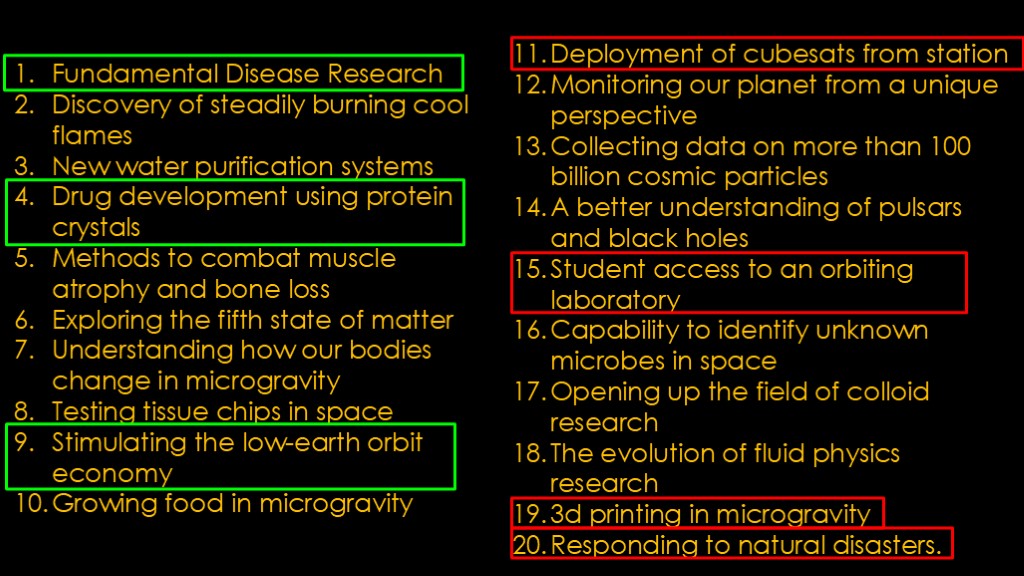
NASA created this list of the top 20 breakthroughs from 20 years in science aboard the station.
I'm not going to read them all, but I do want to highlight a few. Disease research and especially drug development seem like useful research, but as far as I can tell there haven't been any breakthroughs in this area.
Stimulating the low-earth orbit economy is pretty obviously not *science*, but it would be a good thing if it were true, but I'm skeptical in this area.
And a lot of these just don't seem very important.
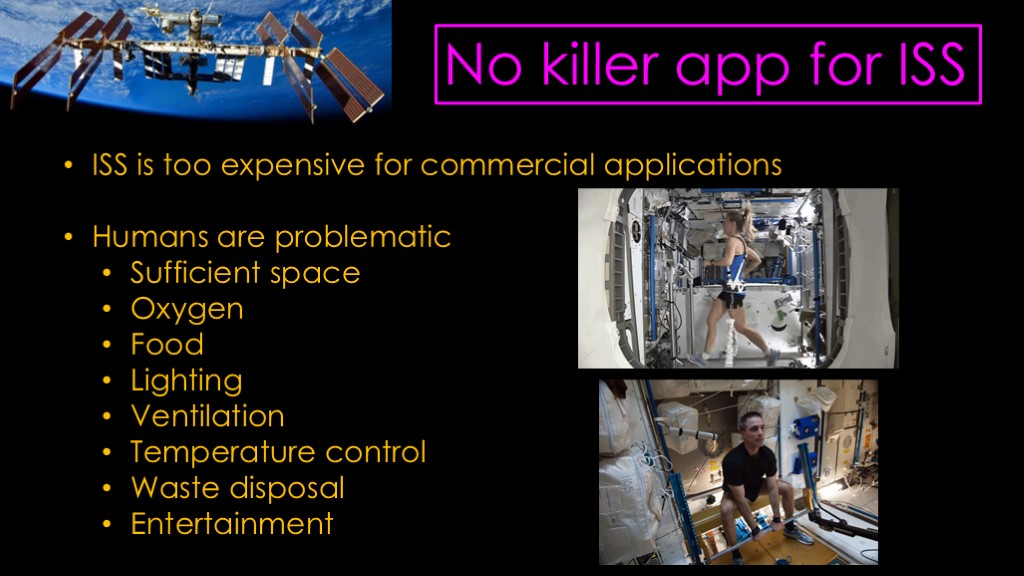
The problem is that NASA has spent a lot of time and money searching for a killer app for ISS without really coming up with one. I'll talk more about this in the video on commercial LEO space stations, but it could be that ISS is too expensive for commercial applications, or it could be that the humans are the problem.
Humans need enough space, oxygen to breathe, food, lighting, ventilation, temperature control, waste disposal, entertainment - the list goes on and on. You need a big station with periodic resupply to keep that going, and everybody expects that you will do your best to keep the astronauts alive. And a lot of your astronaut time goes towards maintenance to keep those astronauts alive.
In return, you get some very useful capabilities - they are very adaptable - but they mess up the microgravity you seek by moving around, by exercising, and by the vibration from the equipment to keep them alive.
Humans are messy.
So this remains an open question for future space stations.